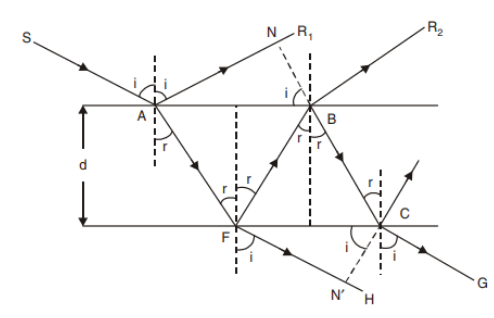Question
Question: A glass plate of refractive index, \[1.5\] is coated with a thin layer of thickness \[d\] and refrac...
A glass plate of refractive index, 1.5 is coated with a thin layer of thickness d and refractive index 1.8. Light of wavelength 648nm travelling in air is incident normally on the layer. It is partly reflected at upper and lower surfaces of the later and the rays interfere constructively is?
A. 30nm
B. 60nm
C. 90nm
D. 120nm
Solution
Interference of light is the property of light in which upon superposition of coherent light (of same frequency) the intensity of light becomes maximum or minimum depending on the phase difference between the rays.
Formula used:
For constructive interference of two rays the condition is given by,
Δ=nλ
where Δ is the path difference between the superposed waves, λ is the wavelength of the light and n is an integer.
Complete step by step answer:
We have here a glass plate of refractive index 1.5 which is coated with a thin layer of thickness d and refractive index 1.8. The passing light is of wavelength is 648nm.Now, the path of the wave can be shown by the following diagram.

So, from the diagram we can see that, ray AR1 and ray BR2 will superposed and will form interference patterns in the glass. Now, we have to find the path difference between these two waves upon a normal incident. Now, the path covered by the ray BR2 is μ2(AF+FB) and the path covered by the ray AR1 is μ1AN. Now, since the two waves reflect from two different surfaces there will be an extra path difference of 2λ due to the change of medium twice of the ray BR2. Hence, the path difference between the ray AR1 and ray BR2 will be,
Δ=μ2(AF+FB)−μ1AN−2λ
⇒Δ=2μ2AF−μ1AN−2λ
Now, from simple trigonometry we can see that,
AF=cosrd and AN=ABsini
Also, AB=dtanr
So, putting these values we have,
Δ=2μ2cosrd−μ12dtanrsini−2λ
Now, using Snell’s law we can write,
Δ=2μ2cosrd−μ12dcosrsinrμ1μ2sinr−2λ
⇒Δ=2μ2cosrd(1−sin2r)−2λ
⇒Δ=2μ2dcosr−2λ
Now, for constructive interference we know, the path difference is Δ=nλ.So, we can write,
2μ2dcosr−2λ=mλ
⇒2μ2dcosr=mλ+2λ
Now, for normal incidence the angle of refraction is 0∘ hence,
cos0∘=1
Therefore,
2μ2d=(m+21)λ
Now, putting the value of the refractive index and wavelength for the first order we have,
dmin=4μ21λ
⇒dmin=4×1.81648nm
∴dmin=90nm
Therefore the rays interfere constructively for the minimum layer thickness of 90nm
Hence, option C is the correct answer.
Note: The formation of the interference pattern does not depend on the refractive index of the incident medium it only depends on the medium of the film or coat. Remember that when a light rays reflects back from one medium to another medium the phase of the light changes by πas changing the path difference of the wave by 2λ factor.
